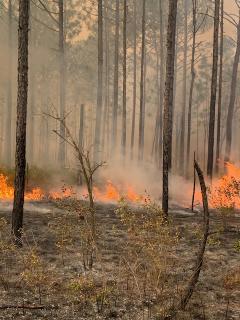Prescribed fire helps make wildfire response safer and easier
GEORGIA—When it comes to wildfires, mitigation and preparation are key. Sometimes, wildfire response teams see specific fire risk reduction efforts pay off firsthand. This was the case for responders to the Barland Road wildfire when it ignited in southwest Mississippi in August 2024.
Six months prior to the wildfire, fire professionals had established fuel breaks and conducted prescribed fires to reduce leaf litter and other dry vegetation in key areas. These actions, which were made possible by a USDA Forest Service Cross-Boundary Wildfire Hazard Mitigation Grant, better prepared the community and the responders to the wildfire.
“Wildfire response happens all over the state, and responders often don’t see the ground until they pull up and start unloading a bulldozer,” said Chris Nothstine, fire ecologist for the National Forests in Mississippi. “When they arrived, they saw fire lines that were already there, so they were familiar with that chunk of ground and were able to work with an area that had burned previously with prescribed fire.”
Prescribed fire is a key tool for reducing the size of wildfires. Removing flammable vegetation and establishing fire lines to remove dead wood and undergrowth down to mineral soil all help to slow the spread and intensity of wildfires.
In August, when weather conditions across the South were extremely dry with many of the Gulf Coast states experiencing drought conditions, these efforts paid off in dividends.
The Barland Road wildfire burned 190 acres, 170 of which were within the prescribed burn treatment area. Without the prior treatment, responders likely wouldn’t have been able to approach the fire front closely, meaning that the fire would need to be boxed in by a much larger area, possibly doubling or tripling the acres burned.
“With the fuels reduced from the previous prescribed burns and the fire breaks installed where they needed to be, we were able to suppress the fire easily and safely,” said Randy Giachelli, Mississippi Forestry Commission Fire Chief. “We were able to get in there to watch it and let it back up to our already installed fire breaks.”
When it comes to responding to fire, sometimes it’s the action beforehand that makes all the difference. This scenario is a great example of how support from grants like the Cross-Boundary Wildfire Hazard Mitigation Grant can bolster wildfire mitigation work.
“This is exactly what the grant funds that we receive from the Forest Service are meant to do: protect lives and protect property through prescribed fire,” said Giachelli. “Unplanned wildfires keep us on the defense, and somebody has to respond to those fires. We ask our firefighters to do that nearly every day. Prescribed fire programs make the response safer and easier.”
Editor’s Note: The Cross-Boundary Wildfire Hazard Mitigation Grant, formerly known as the Stevens Grant, is awarded to support fire management activities in areas at risk from wildfires within proximity of federal lands. The national forest mitigation practices supported by this grant help protect against damage to land and property and increase safety for responders.

